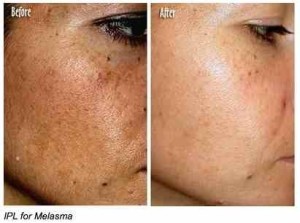Melasma is a skin condition where distinct, discolored formations appear on the skin, known as macules. Though they are flat and usually less than 1 centimeter wide, as well as harmless, many women seek melasma treatment. The appearance is similar to dark patches of freckles on the skin, which contribute to uneven skin tone. Approximate 6 million American women experience melasma, with it affecting 45 to 50 million women worldwide. While it may appear in men, 90 percent of cases are in women.
Melasma treatment is possible with topical solutions and laser therapy. The topical solutions vary in terms of strength, with the more potent solutions only available by prescription. A consultation with a board-certified dermatologist will guide you through the options for melasma treatment.
WHAT CAUSES MELASMA
Melasma, also known as chloasma, is a hyperpigmentation of the skin that appears as brown splotches on the face. Unfortunately, scientists and doctors do not understand the exact cause of the skin condition. The fact that is shows up on many pregnant women, where it’s known as a pregnancy mask, suggest that it’s tied to hormone fluctuations. The following are possible triggers for the condition:
- Birth control pills
- Pregnancy
- Hormone replacement therapy
- Genetic predisposition
- Race
- Certain medications
- Excessive ultraviolet (UV) light exposure
Clinical studies suggest that women typically develop melasma in the summer months, where UV light exposure it at its highest, according to MedicineNet.com. Melasma tends to fade or be less apparent during winter months.
The dark patches of melasma result from increased melanin production below the skin’s surface. It coincides with hormonal fluctuations, particularly of estrogen and progesterone. UV rays are also a main trigger due to their affect on skin. Melanin production is like the body’s natural sunscreen when skin reacts with UV light. Sunlight causes oxidation in lipids within the cell membrane, which results in the loss of electrons to free radicals. A defense mechanism kicks in with melanocytes triggering melanin production.
Those with olive or darker skin tones also have higher chances of developing melisma.

A consultation with a board-certified dermatologist will guide you through the options for melasma treatment, such as topical solutions and laser therapy. Image courtesy of www.realself.com*
MELASMA TREATMENT OPTIONS
Everyone should wear sunscreen everyday, especially on the face. If you have experienced melasma in the past are prone to its development, broad-spectrum sunscreen is especially important. It lessens the affects of UVA and UVB light rays from triggering melanin production. Physicians recommend SPF 30 or higher. Each day, apply it 20 minutes before sun exposure. If you are in the sun for extended periods of time and swimming or sweating, apply every two hours. Sunscreen is an important preventative measure than can decrease your need for melasma treatment.
If you already have the uneven skin tone that melasma creates with a face full of brownish blotches, many an appointment with a board-certified dermatologist. He or she will inform you on melasma treatment options. The two most common options are topical solutions and laser procedures.
Topical
Hydroquinone is a type of phenol and aromatic organic compound used topically for skin whitening. Using a hydroquinone solution bleaches the skin to minimize the appearance of the brown splotches on the face from melasma. In the United States, it’s available over the counter in 2 percent formulations. For the stronger 4 percent formulation, it requires a prescription. It reduces the production of melanin. The topical solution usually takes three to six months for efficacy in reducing the appearance of melasma.
Laser Treatments
Melasma requires specific wavelengths in laser treatment. Two lasers are appropriate for melasma treatment that specifically target issues with hyperpigmentation. The Fraxel re:store has a dual laser setting, with the 1,550 nanometer wavelength suited to treat melasma. Lutronic’s Spectra laser is a Nd:YAG Q-switch laser with four modes. Its 1,064-nanometer wavelength also addresses the issue of hyperpigmentation and uneven skin tone.
Both lasers work by eradicating the organelles that contain the extra melanin. Once they are destroyed, the body absorbs them and eventually eliminates them from the body. Immediately after treatment hypopigmentation may occur, which is when the skin becomes lighter than usual. The skin is then restored to a more even tone.
If you are currently suffering from the appearance of an uneven skin tone and brown blotches, schedule a free consultation with Dr. Umar. Dr. Umar has helped thousands of Los Angeles residents achieve radiant, beautiful skin at FineTouch Dermatology.
